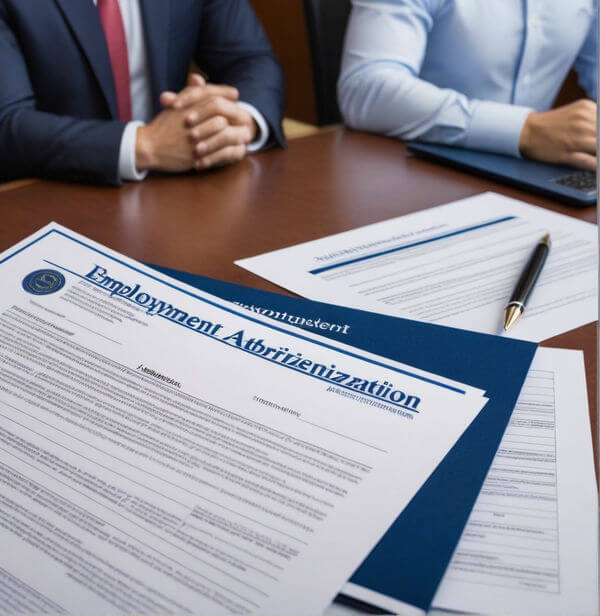
An Employment Authorization Document: What Is It?
Form I-766 is the official title for the Employment Authorization Document (EAD), also known as a work permit. This document is essential for individuals who are in the country while waiting for the result of their green card application since it serves as a crucial indicator of their legal right to work in the country and allows them to continue their employment during this time. It is also accessible to K-1 fiancé visa holders, spouses of H-1B visa workers, and F-1 student visa holders under specific circumstances, allowing them a pathway to gainful employment. Particularly for those linked to a green card application, the EAD provides significant employment flexibility, permitting work with any employer on the "open market" and thus, not restricting the holder to a single employer as seen with H-1B visas. The goal of this guide is to delve into the details of the EAD, addressing frequently asked questions and clarifying its application process and benefits. This expansive eligibility makes the EAD a vital tool for non-citizens seeking to navigate their career opportunities in the U.S. while maintaining or transitioning their immigration status.
Application Cost for an Employment Authorization Document (EAD)
The fee to apply for an Employment Authorization Document (EAD) is set at $410. Additionally, applicants might incur an extra $85 charge for biometric services, making the total potential cost for applying $495.
Understanding EAD Eligibility
To secure a work permit, the necessary step involves submitting Form I-765, also known as the Application for Employment Authorization. This form should not be confused with Form I-766, which refers to the Employment Authorization Document (EAD) itself, the topic of discussion here. Individuals who already possess a green card or those working in the U.S. under a non-immigrant work visa (e.g., H-1B) are exempt from applying for an EAD, as their current status already permits employment in the country. However, if you are awaiting approval of your green card or asylum request, or if you hold a nonimmigrant visa that requires an EAD to work legally, filing Form I-765 is necessary. It's important to note that individuals applying for a green card from outside the U.S. through consular processing are automatically granted work authorization upon entering the U.S. and thus do not need to apply for an EAD.
Applying for an Employment Authorization Document (EAD)
To apply for an EAD, every applicant must complete and submit Form I-765. However, the specific evidence required varies by your individual circumstances. For instance, F-1 students seeking off-campus employment due to financial hardship must include evidence such as:
- Proof of being an F-1 student for at least one full academic year.
- Verification that the job will not disrupt your studies.
- Evidence of carrying a full course load.
- Documentation demonstrating that employment is necessary to alleviate severe economic hardship.
These criteria specifically apply to "F-1 Students Seeking Off-Campus Employment Due to Severe Economic Hardship," but there are other scenarios for F-1 students, and numerous other categories each with unique documentation requirements.
Generally, the following documents are essential for anyone filing Form I-765:
- A copy of the photo page of your passport.
- Two 2x2 inch passport-style photographs, with your alien registration number and full name clearly written on the back.
- Your I-94 travel record.
- Copies of any previous work permits, if you have them.
- A copy of your U.S. visa found in your passport.
If you're applying for an EAD subsequent to submitting Form I-485 for a green card, you should include proof that your green card application is pending. Form I-765 can also be filed concurrently with your green card application, streamlining the process.
Preparing for Employment in the U.S.
Once you secure your work permit, if you're new to working in the United States, your next step is to obtain a Social Security number (SSN). The good news is, you can apply for an SSN or a replacement card as part of your work permit application process, eliminating the need to visit a Social Security Administration office in person. Upon beginning employment, your employer will ask you to fill out an I-9 form (Employment Eligibility Verification) to confirm your eligibility to work in the U.S. With a valid SSN and work permit, it's against the law for employers to discriminate against you based on your immigration status. Remember, working in the U.S. means you're obligated to pay payroll and income taxes just like any other worker. Not fulfilling these tax obligations can lead to severe consequences, impacting your ability to apply for U.S. citizenship in the future.
Risks of Unauthorized Employment in the U.S.
Engaging in unauthorized work in the United States can jeopardize your entire path to obtaining a green card. USCIS pays particular attention to applicants who have engaged in work without the proper authorization, risking their future applications and status adjustments. While there are narrow exceptions, such as spouses of U.S. citizens who might not face denial for a green card due to previous unauthorized work, the consequences are generally severe.
Individuals found working without authorization may face entry bans to the United States, ranging from three to ten years, based on the duration of unauthorized employment. For instance, engaging in unauthorized work on a tourist visa and later applying for a student visa will render you ineligible due to the unauthorized employment history. It's important to note that even short-term or casual work requires proper authorization; being compensated for even a few hours of unauthorized work can lead to significant legal and immigration challenges.
Thankfully, securing a work permit through Form I-765 is a straightforward process, particularly when filed alongside your green card application. Holding a valid Employment Authorization Document (EAD) not only aligns with legal requirements but also opens up opportunities to work in the U.S. while awaiting green card processing. Regardless of immediate work plans, applying for a work permit is advisable to avoid potential complications and to be prepared for prospective employment opportunities.
Obtaining a New or Renewed Work Permit (EAD)
If you find yourself needing a new Employment Authorization Document (EAD, Form I-766) due to expiration or loss, the renewal or replacement process is designed to be straightforward. However, it's crucial to first confirm your continued eligibility for employment authorization in the U.S.
Renewing Your EAD
To renew an EAD that's nearing or has reached its expiration, you'll need to submit a fresh Form I-765 application. This process is similar to the initial application, including the necessity to cover a filing fee unless you are eligible for and have successfully obtained a fee waiver. It's advisable to initiate this renewal process well before the current EAD's expiration, as USCIS allows applications to be filed up to 6 months in advance. This proactive approach helps ensure there's no gap in your employment authorization.
How to Request a Replacement for Your EAD
Should your Employment Authorization Document (EAD) be damaged, lost, or stolen, you can apply for a replacement by filing Form I-765, along with the necessary fees. If you're awaiting an EAD that hasn't arrived, reaching out to U.S. Citizenship and Immigration Services (USCIS) to report the non-delivery is a recommended step.
In instances where you receive an EAD with incorrect information due to your own error, you'll need to re-submit Form I-765, include the required filing fee, the original EAD, and any supporting evidence needed for the corrections, as outlined in the filing instructions. Conversely, if the mistake on the EAD stems from a USCIS error, you should return the incorrect EAD along with supporting documentation for the correction and a detailed explanation of the mistake to the National Benefit Center, or the service center that handled your latest work authorization application. In cases of USCIS errors, there's no requirement to re-file Form I-765 or to pay additional fees.

